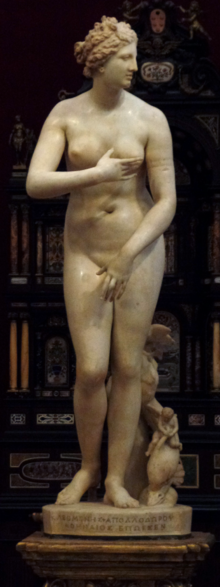Cleomenes (sculptor I)
Cleomenes is believed to be the name of several ancient Greek sculptors from Athens . Pliny mentions an artist of this name as the originator of the Thespiaden group of statues . This work is said to be Lucius Mummius after the destruction of Corinth in 146 BC. BC to Rome . Gaius Asinius Pollio acquired in the 1st century BC The group of statues and had them put up in the first public library in Rome, which he founded.
Cleomenes is also said to have created the Venus Medici , which is now in the Uffizi Gallery in Florence . The base bears the following inscription:
- ΚΛΕΟΜΕΝΗΣ ΑΠΟΛΛΟΔΩΡΟΥ
- ΑΘΗΝΑΙΟΣ ΕΠΟΕΣΕΝ
- ("Cleomenes, the son of Apollodorus from Athens")
The suspicion was expressed that this inscription was added later and that the statue could be assigned to another artist. Supporters of the theory that the inscription is authentic express the suspicion that one only doubts the authenticity in order to attribute the statue to a more famous artist. Because of the shape of the Ω, the work is dated to the time after 403 BC. The style of the statue is based on Aphrodite von Knidos des Praxiteles . It is assumed that Cleomenes was born between 363 BC. BC, the time of Praxiteles, and 146 BC. Lived.
His descendants may include two other sculptors named Kleomenes: Kleomenes (Sculptor II) and Kleomenes (Sculptor III) .
literature
- Walter Hatto Gross : Kleomenes 9th In: The Little Pauly (KlP). Volume 3, Stuttgart 1969, Col. 244.
- Christiane Vorster : Cleomenes II . In: Rainer Vollkommer (Hrsg.): Künstlerlexikon der Antike . Volume 1: A-K. Saur, Munich / Leipzig 2001, ISBN 3-598-11413-3 , pp. 414-415.
Remarks
| personal data | |
|---|---|
| SURNAME | Cleomenes |
| BRIEF DESCRIPTION | Greek sculptor |
| DATE OF BIRTH | between 363 BC BC and 146 BC Chr. |
| DATE OF DEATH | between 363 BC BC and 146 BC Chr. |
